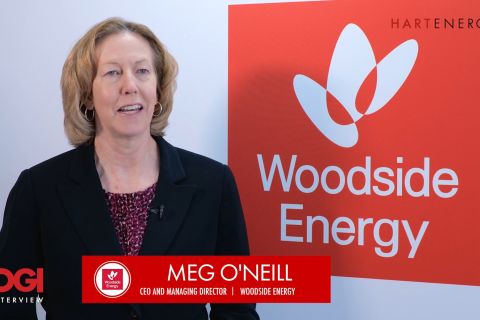When compared to conventional plays, unconventional resources were traditionally seen as uneconomic since they require some sort of artificial stimulation (such as hydraulic fracturing) or lift (steam induction) to sufficiently increase the mobility of the hydrocarbon fluids. But with the advent of higher fuel prices and technological advances, many of these plays are now economic.
The greatest expansion of unconventional play activity has occurred within the US in the Barnett, Eagle Ford, and Bakken plays. Huge oil reserve figures have been quoted for those plays, which could total up to 30 Bbbl. These forecasts have attracted not only US energy companies but also international and multinational companies.

FIGURE 1. A full-azimuth seismic-driven reservoir characterization was performed from a full-azimuth acquisition in the Eagle Ford shale. (Data in upper left image courtesy of Seitel; images courtesy of Paradigm)
Brittle reservoirs
Both the Barnett and Eagle Ford reservoirs have a propensity for brittleness, which can make them susceptible to fracturing. It should thus be no surprise that the industry has focused on predicting areas of potentially increased permeability due to the presence of natural fracturing that may then be enhanced with hydraulic fracturing.
The current methodology is to identify these sweet spots and optimize production with intense horizontal drilling and hydraulic fracturing. Wells and sometimes conventional seismic are commonly used when predicting rock properties to determine the trend of maximum stress and then define the wellbore path to facilitate hydraulic fracturing. Some companies also are acquiring microseismic data at their wellbores for more direct measurements of anisotropic rock properties, while others are mostly identifying zones of increased brittleness to drill in between existing wells. In the Barnett shale, for example, the net result for these workflows has been commonly reported as 80% of the production from 30% of the completions.
Reservoir complexity
Why do 70% of the completions fail to significantly contribute to production? First, the well-bore may not be optimally positioned at an appropriate angle to regional stresses. This may be a result of inaccurate rock property calculation and mapping or complex structural fabric overprinted by several regional events. Additionally, the structures of interest – fractures and small faults or facies changes – are sub-seismic and cannot be delineated from conventional seismic using conventional processing. Finally, in the case where only wells are used for delineation, the underlying assumption is that rock property information can be carried between the wells. The problem with looking at an extensive shale formation and pursuing a simple infill program is that these reservoirs are not isotropic or homogenous. The actual reservoirs, like in the Eagle Ford, can be the result of drastic facies changes, and the rock properties are complex. To create models that are accurate and successfully predictive, a more rigorous approach is required.
Reservoir characterization
Enhanced-performance technology and tools designed to facilitate accurate reservoir characterization have recently become available. These provide solutions for unconventional play types with an integrated and multidomain approach across the entire workflow, from full-azimuth processing and imaging to reservoir engineering, to reduce uncertainties in the decision-making, planning, drilling, and completion process.

FIGURE 2. A seismic facies map paired with curvature attributes highlights the heterogeneities of the shale and suggests areas of possible increased fracturing within the Eagle Ford reservoir.
Despite the challenge of vertical resolution, conventional seismic data offer valuable information regarding lithology, fluid content, and in situ stress events. For the accurate extraction of rock properties from seismic data without azimuthal biasing, a new full-azimuth angle domain imaging and analysis technology has been designed to deliver unsectored data for subsurface velocities, structural attributes, rock and fluid properties, and reservoir characteristics. As this process provides in situ recovery of continuous azimuth and angle prestack data in depth, additional information from both modern and legacy seismic data (especially wide-and rich-azimuth data with long offsets) is produced. In low-permeability and fracture system plays this technology, with its solutions for anisotropic tomography, provides stress and fracture detection for accurate reservoir characterization correlating to shale properties.
In a case study of the Eagle Ford formation full-azimuth reflection angle gathers for a 36° opening angle are shown in Figure 1. The accompanying minimum-stress fracture orientation map with measured intensity overlies the most apparent brittle zones shown in rainbow colors. To map the spatial distribution of the estimated highest brittleness material (vs. ductile), the derived seismic attributes, Poisson’s ratio, and Young’s modulus were calculated from a simultaneous inversion and analyzed through advanced cross-plotting for geobody detection and mapping.
Interpreting seismic attributes through enhanced visualization, such as advanced merge methods or opacity, layering, and interactive cross-plot techniques, provides a more precise reservoir characterization, enhancing predictions of the spatial conditions of trapping systems and the distribution of subsurface lithology and reservoir properties. New, highly parallelized compute power capabilities provided by graphics processing units to perform computations traditionally handled by central processing unit power were first adapted for improved visualization. They also can be used for on-the-fly calculations to extract post-stack information such as frequency-dependent attributes that can efficiently contribute to an interpretation workflow. With proper calibration to in situ conditions observed at the wells, trends can be identified and mapped for sweet spot determination.
Information from log evaluation can be used to automatically calculate a predictive model directly or can be combined with the structural interpretation for a more integrated approach.
Unconventional plays have poor reservoir properties and are difficult to interpret with seismic data. This may be due to the negligible acoustic impedance contrast; the presence of gas, which degrades compressional wave imaging; or multiple stress episodes. The challenge is even more complex in the presence of faults reactivated after the time of deposition. A proportional reservoir top and base slice extraction is certainly the best approach for understanding the seismic stratigraphy if the depositional sequence is not complicated by progradation or tectonic events within the interpreted seismic zone. If there is faulting or any internal variation of the sediment depositional sequence, however, this approach will lead to an erroneous geologic interpretation.
To avoid such bias, the interpretation should be validated in the paleogeographic (geochronological) sense at the time of deposition with a change of reference from X, Y, and Z to U, V, and T, where T is the geologic time and U and V are the paleo-coordinates. This transform enables flattening in the UVT space of both the interpretation and seismic data and helps the interpreter understand the relationship between geological events and validate the structural interpretation.
Through waveform seismic facies classification, seismic data can reveal the extreme heterogeneity that characterizes unconventional reservoirs. This technique leads to an understanding of the seismic response variability within the reservoir. The correlation at the well location helps illustrate the relationship between local and large-scale homogeneous patterns to reveal heterogeneities distribution (Figure 2).
The combination of interpretation, characterization, and reservoir modeling leads to better control of drilling risk. By integrating all the information in a 3-D canvas, potential hazards can be identified and mitigated. Using automated fault-enhanced extraction, the interpreter can extract lineaments along horizontal and vertical slices at the discontinuities (along fault planes) and link them into fault planes. The ability to investigate both the lineaments and the discontinuities associated with them can provide insight into potential zones of enhanced fracturing/permeability vs. areas of permeability boundaries.
Producing hydrocarbons economically from low-permeability unconventional plays drives the need for well path and engineering design optimization at every stage of the planning and drilling process. The subtle nature of fracturing and facies changes in unconventional plays requires the use of rigorous full-azimuth seismic processing, imaging, inversion, interpretation, and reservoir modeling. Designing wells within a 3-D structural model that integrates all relevant features can shorten well-planning cycle times, improve well placement, and reduce drilling risk while facilitating the decision-making process.
Recommended Reading
Deepwater Roundup 2024: Offshore Australasia, Surrounding Areas
2024-04-09 - Projects in Australia and Asia are progressing in part two of Hart Energy's 2024 Deepwater Roundup. Deepwater projects in Vietnam and Australia look to yield high reserves, while a project offshore Malaysia looks to will be developed by an solar panel powered FPSO.
E&P Highlights: April 1, 2024
2024-04-01 - Here’s a roundup of the latest E&P headlines, including new contract awards.
Petrobras to Step Up Exploration with $7.5B in Capex, CEO Says
2024-03-26 - Petrobras CEO Jean Paul Prates said the company is considering exploration opportunities from the Equatorial margin of South America to West Africa.
Exxon Versus Chevron: The Fight for Hess’ 30% Guyana Interest
2024-03-04 - Chevron's plan to buy Hess Corp. and assume a 30% foothold in Guyana has been complicated by Exxon Mobil and CNOOC's claims that they have the right of first refusal for the interest.
The OGInterview: How do Woodside's Growth Projects Fit into its Portfolio?
2024-04-01 - Woodside Energy CEO Meg O'Neill discusses the company's current growth projects across the globe and the impact they will have on the company's future with Hart Energy's Pietro Pitts.





